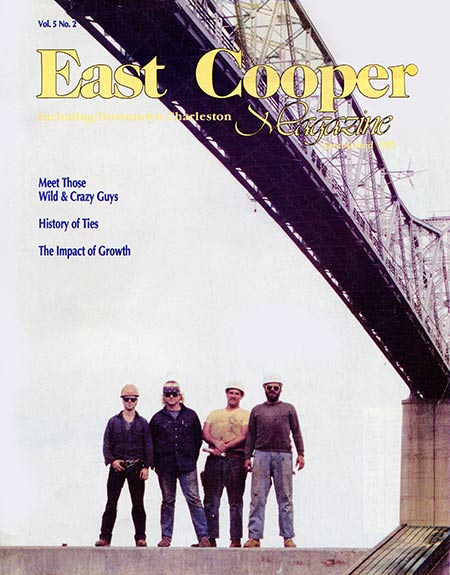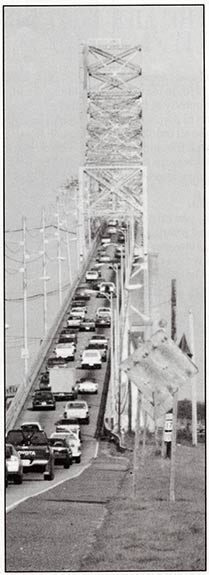The Impact of Growth
By Jane Laureu
circa May/June 1991, East Cooper Magazine
 Changes are coming to the East Cooper area at a breathtaking rate and those changes could adversely affect the environment and our quality of life – the very things that bring so many people here.
Changes are coming to the East Cooper area at a breathtaking rate and those changes could adversely affect the environment and our quality of life – the very things that bring so many people here.
Some of the changes are painfully evident; other greater ones are on the drawing boards, but coming nevertheless. The dramatic loss of trees near K-Mart and the Old Georgetown Highway foretell the coming of the Mark Clark Expressway and more immediate connections with North Charleston and the Isle of Palms. That spells growth.
With the completion of the Mark Clark, North Area and West Ashley residents will soon realize they can live in Mount Pleasant – very near the beaches – and be only 10 minutes away from the Navy Yard or 20 minutes from Summerville, Ladson and Hanahan. It will be possible to live East of the Cooper and have the twin benefits of beaches and jobs in the North Area.
If you think Mount Pleasant has grown fast in the last five years, you haven’t seen anything yet. Dunes West, Belle Hall, Charleston National and other massive developments will double the size of Mount Pleasant in the next five to 10 years. And  when next door Daniel Island is developed, it is an easy bet that much of that traffic will come our way. And those are just the big developments. There are a dozen smaller developments beckoning people to move East of the Cooper.
when next door Daniel Island is developed, it is an easy bet that much of that traffic will come our way. And those are just the big developments. There are a dozen smaller developments beckoning people to move East of the Cooper.
What will all of this mean for the environment of the East Cooper area?
Without question it will be hit hard. Water quality in creeks and waterways will be hurt by runoff from developments, destroying the possibility of harvesting shellfish from local creeks (this is already happening); open spaces, rural areas and wildlife habitat will be reduced or eliminated; traffic congestion will contribute to air pollution; the waste of fossil fuels and serious congestion; beloved avenues of oaks and towering pines will be cut to make way for roads, malls, golf courses and homes. The quality of life that brought people here will be substantially lost.
Many of the adverse effects of development can be avoided because, remarkably, it is not so much growth per se that hurts the environment but the lack of planning for it. While the East Cooper area has its share of planners, the question is, have they identified the correct problems and are they planning the right solutions?
With the right kind of planning, traffic congestion can be avoided; green spaces and wildlife can be significantly protected while allowing development; toxic runoff can be prevented or minimized; and trees with forests can exist beautifully with mall parking lots, commercial development and subdivisions.
Let’s examine just one of growth’s impacts and how it can be reduced.
Perhaps the most expensive and vexing problem for planning officials anywhere in the United States – and Mount Pleasant is no exception – is traffic. The question is not how to accommodate large amounts of traffic and pay for increasingly expensive roads but rather can we reduce the amount of traffic?
The problem is that “modern” cities have been designed so that one cannot function without a car. Many would gladly walk to work, to shop, to movies or to a drugstore if it were remotely feasible. In the early villages – two examples are Old Village in Mount Pleasant and historic Charleston – small commercial enterprises were mixed throughout the residential areas and everything was connected by small streets and sidewalks. Pedestrians were buffered from moving traffic by parked cars along the street, so walking was a pleasant and safe experience.
Walking around downtown Charleston or the Old Village of Mount Pleasant is easy and delightful even today. Shopping is fun in Charleston. There isn’t much shopping or commerce to be done in Old Village anymore, but people enjoy strolling to the cafe, the consignment shop or the barber. Actually, people enjoy just strolling there and bumping into friends. Contrast that with a stroll down Highway 17 bypass. It isn’t done because it’s dangerous and distinctly unpleasant.
Why is new Mount Pleasant so different from old Mount Pleasant? Why are James Island and West Ashley so different from Historic Charleston?
The answer is that modern zoning codes and regulations outlaw the design of those old cities. It is illegal today to build a city like Charleston. The streets are too narrow, the houses are too close to the street, the shopping areas need to be set back from the road and accommodate enormous amounts of parking. These are the laws. And when city and officials and planners scrupulously follow laws you get modern America – Ashley Plaza Mall, St. Andrews Shopping center, East Cooper Plaza and an unending river of cars.
The “new” zoning regulations dictate that we will never again see cities like Charleston, McClellanville, Cape Cod, St. Augustine, Savannah, San Francisco or Cambridge. Ironically, people so desperately want to live in these cities that they will pay astronomical prices to do so. Simply contrast the cost of a house in downtown Charleston with one in James Island for your proof.
The changes in zoning stemmed from the early experiences where dirty and noisy businesses and industries were incompatible with a pleasant home life. The solution was to rigorously separate all commercial and industrial activities from all residential areas. But we have continued to these rigorous separations beyond the time when they were needed. Many activities were separated out that should have remained an integral part of each neighborhood.
Now, to go to the grocery store, see a movie, pick up a prescription or eat at a restaurant, you must travel some distance and you must do it by car. Certainly some residents are located near commercial activities and could walk. But the new design of our cities is antithetical to pedestrians and bicyclists. It’s not enough to be close, the walk should also be pleasant and safe. For example, East Cooper plaza is very close to East Cooper Estates and the Groves. But residents are literally blocked by a wall from getting there by foot or bicycle. There are no sidewalks down Cottingham. When the Plaza was designed, planners thought only about cars – they did think about any other mode of transportation which might have reduced the number of cars needed to get there (and consequently the need for parking and the loss of trees).
One planning solution? Rewrite zoning codes to allow a small measure of appropriate commercial activity in residential areas where people need and can walk to it. Allow the small scale corner grocery store, the drug store, the cafe, the barber shop, the hardware store. Another solution is to design bikeways and walkways connecting residential and commercial areas to each other, to schools and more.
The benefits of designing our town with the pedestrian in mind are many. We will reduce traffic and the need for more asphalt. We will save fossil fuels and reduce air pollution. We will preserve more trees.
And there is another bonus. We will revive the simple pleasure of strolling down the street and encountering our neighbor doing the same. Psychologists say Americans spend too much time watching television and are starved for social interaction. But we are deprived of it as we sit in our small boxes called cars. We live in subdivisions with many people but we are isolated in our homes and automobiles and live in communities for years without knowing who lives three houses down.
Growth in Mount Pleasant does not have to be a bad thing. Making room for walkers and cyclists will go a long way toward mitigating some of the very real changes to the environment that will come with the explosive growth of the ’90s.

Leave a Reply